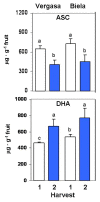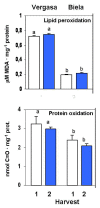Antioxidant systems from Pepper (Capsicum annuum L.): involvement in the response to temperature changes in ripe fruits
- PMID: 23644886
- PMCID: PMC3676799
- DOI: 10.3390/ijms14059556
Antioxidant systems from Pepper (Capsicum annuum L.): involvement in the response to temperature changes in ripe fruits
Abstract
Sweet pepper is susceptible to changes in the environmental conditions, especially temperatures below 15 °C. In this work, two sets of pepper fruits (Capsicum annuum L.) which underwent distinct temperature profiles in planta were investigated. Accordingly, two harvesting times corresponding to each set were established: Harvest 1, whose fruits developed and ripened at 14.9 °C as average temperature; and Harvest 2, with average temperature of 12.4 °C. The oxidative metabolism was analyzed in all fruits. Although total ascorbate content did not vary between Harvests, a shift from the reduced to the oxidized form (dehydroascorbate), accompanied by a higher ascorbate peroxidase activity, was observed in Harvest 2 with respect to Harvest 1. Moreover, a decrease of the ascorbate-generating enzymatic system, the γ-galactono-lactone dehydrogenase, was found at Harvest 2. The activity values of the NADP-dependent dehydrogenases analyzed seem to indicate that a lower NADPH synthesis may occur in fruits which underwent lower temperature conditions. In spite of the important changes observed in the oxidative metabolism in fruits subjected to lower temperature, no oxidative stress appears to occur, as indicated by the lipid peroxidation and protein oxidation profiles. Thus, the antioxidative systems of pepper fruits seem to be involved in the response against temperature changes.
Figures










Similar articles
-
Peroxisomes from pepper fruits (Capsicum annuum L.): purification, characterisation and antioxidant activity.J Plant Physiol. 2003 Dec;160(12):1507-16. doi: 10.1078/0176-1617-01008. J Plant Physiol. 2003. PMID: 14717445
-
Metabolism of reactive oxygen species and reactive nitrogen species in pepper (Capsicum annuum L.) plants under low temperature stress.Plant Cell Environ. 2012 Feb;35(2):281-95. doi: 10.1111/j.1365-3040.2011.02310.x. Epub 2011 Apr 7. Plant Cell Environ. 2012. PMID: 21414013
-
Physiology of pepper fruit and the metabolism of antioxidants: chloroplasts, mitochondria and peroxisomes.Ann Bot. 2015 Sep;116(4):627-36. doi: 10.1093/aob/mcv121. Epub 2015 Jul 28. Ann Bot. 2015. PMID: 26220658 Free PMC article.
-
Characterisation and changes in the antioxidant system of chloroplasts and chromoplasts isolated from green and mature pepper fruits.Plant Biol (Stuttg). 2009 Jul;11(4):613-24. doi: 10.1111/j.1438-8677.2008.00149.x. Plant Biol (Stuttg). 2009. PMID: 19538399
-
The Proteome of Fruit Peroxisomes: Sweet Pepper (Capsicum annuum L.) as a Model.Subcell Biochem. 2018;89:323-341. doi: 10.1007/978-981-13-2233-4_14. Subcell Biochem. 2018. PMID: 30378030 Review.
Cited by
-
Identification of Compounds with Potential Therapeutic Uses from Sweet Pepper (Capsicum annuum L.) Fruits and Their Modulation by Nitric Oxide (NO).Int J Mol Sci. 2021 Apr 25;22(9):4476. doi: 10.3390/ijms22094476. Int J Mol Sci. 2021. PMID: 33922964 Free PMC article.
-
Class III Peroxidases (POD) in Pepper (Capsicum annuum L.): Genome-Wide Identification and Regulation during Nitric Oxide (NO)-Influenced Fruit Ripening.Antioxidants (Basel). 2023 Apr 27;12(5):1013. doi: 10.3390/antiox12051013. Antioxidants (Basel). 2023. PMID: 37237879 Free PMC article.
-
Spatial and temporal regulation of the metabolism of reactive oxygen and nitrogen species during the early development of pepper (Capsicum annuum) seedlings.Ann Bot. 2015 Sep;116(4):679-93. doi: 10.1093/aob/mcv023. Epub 2015 Mar 25. Ann Bot. 2015. PMID: 25808658 Free PMC article.
-
Nitric oxide-dependent regulation of sweet pepper fruit ripening.J Exp Bot. 2019 Aug 29;70(17):4557-4570. doi: 10.1093/jxb/erz136. J Exp Bot. 2019. PMID: 31046097 Free PMC article.
-
Highly efficient CRISPR/Cas9-RNP mediated CaPAD1 editing in protoplasts of three pepper (Capsicum annuum L.) cultivars.Plant Signal Behav. 2024 Dec 31;19(1):2383822. doi: 10.1080/15592324.2024.2383822. Epub 2024 Jul 25. Plant Signal Behav. 2024. PMID: 39052485 Free PMC article.
References
-
- Howard L.R., Talcott S.T., Brenes C.H., Villalon B. Changes in phytochemical and antioxidant activity of selected pepper cultivars (Capsicum species) as influenced by maturity. J. Agric. Food Chem. 2000;48:1713–1720. - PubMed
-
- Mateos R.M. Ph.D. Thesis. University of Granada; Spain: Jun 20, 2006. Pepper Antioxidants: Biochemical and Molecular Study of the Fruit Ripening and the Response to Abiotic Stress.
-
- Palma J.M., Corpas F.J., del Río L.A. Plant Vitamin Antioxidants and Their Influence on the Human Diet. In: Papareschi A., Eppolito H., editors. Fruit and Vegetable Consumption and Health. Nova Science Publishers, Inc; New York, NY, USA: 2009. pp. 127–138.
-
- Palma J.M., Jiménez A., Corpas F.J., Mateos R.M., Martí M.C., Sevilla F., del Río L.A. Role of ascorbate on the fruit physiology of pepper (Capsicum annuum L.) Funct. Plant Sci. Biotech. 2011;5:56–61.
-
- Martí M.C., Camejo D., Vallejo F., Romojaro F., Bacarizo S., Palma J.M., Sevilla F., Jiménez A. Influence of fruit ripening stage and harvest period on the antioxidant content of sweet pepper cultivars. Plant Foods Hum. Nutr. 2011;66:416–423. - PubMed
Publication types
MeSH terms
Substances
Associated data
- Actions
- Actions
- Actions
LinkOut - more resources
Full Text Sources
Other Literature Sources
Medical

